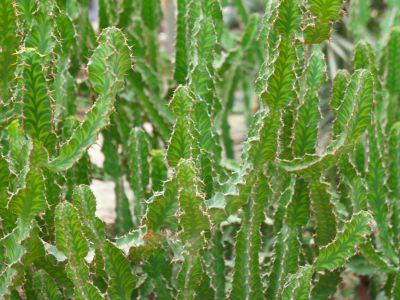Dragon Bone Euphorbia
Gardeners with unusual taste will go nuts for dragon bone cactus (Euphorbia lactea). The triangular branches form an eclectic scaffold upon which tiny green heart-shaped leaves and numerous reddish pink spines occur. This succulent produces latex milky sap, which may be toxic to some gardeners, so it’s best to use gloves when handling broken stems. Here are a few tips on how to grow dragon bones as an in-ground plant or potted specimen for the home interior. Dragon bone is indigenous to India but can be grown in United States Department of Agriculture zones 10 and 11. The plant may achieve 6 feet (1.8 m.) tall by 3 feet (.9 m.) wide in containers but exceeds that in the ground, growing up to 12-15 feet (3.6-4.5 m.) in height. The tiny leaves fall off as the spines are produced and are only present on new growth. Overall the plant is leafless, thorned and has numerous vertical branches rising from a stout central leader. The branches are mottled green with white lines. Flowers are rare, tiny and inconspicuous. Propagation is best accomplished through stem cuttings. These must be allowed to callus before planting.
How to Grow Dragon Bones
Northern gardeners will do best if they plant the cactus in a well-draining pot. Choose a container that will evaporate excess moisture, such as a clay pot. Use a cactus soil mix or add gritty sand and pebbles to a commercial plant formula. This euphorbia doesn’t mind being crowded in its pot. In-ground plants benefit from added grit or install the plant in a rocky area of the garden that has mixed loam. Dragon bone prefers full sun with some protection from the midday light. Propagation of dragon bone is simple through stem cuttings. Use a sterile, sharp implement and allow to dry out for a few days and callus at the cut end. Use a soilless mixture to root the cuttings. Keep lightly moist but not soggy. Once the cutting has developed roots, transfer to a container with cactus mix.
Caring for Dragon Bone Plants
As part of dragon bone plant care, you should water regularly, at least once per week in the growing season, but allow soil to dry out in the top few inches (7.6 cm.). Do not allow the roots to stand in water. In the winter, water once per month to allow for the dormant period. Prune the plant as needed to remove errant stems or keep it in a tidy habit. Use gloves when handling the plant to avoid contact with the toxic sap. Use insecticidal soap to control the occasional pests such as mealybugs, aphids, and spider mites. Every two weeks in the growing season use water soluble fertilizer diluted to half for potted plants. Suspend feeding in fall and winter. In-ground plants should also be fertilized with a half dilution, which will replace the regularly scheduled irrigation. Dragon bones is a distinctive plant that is easy to care for and both drought and deer resistant. Try it in your home or landscape for matchless appeal and evocative design.
